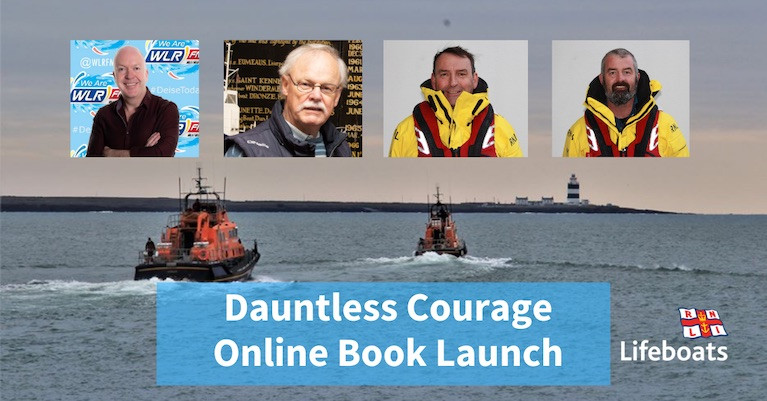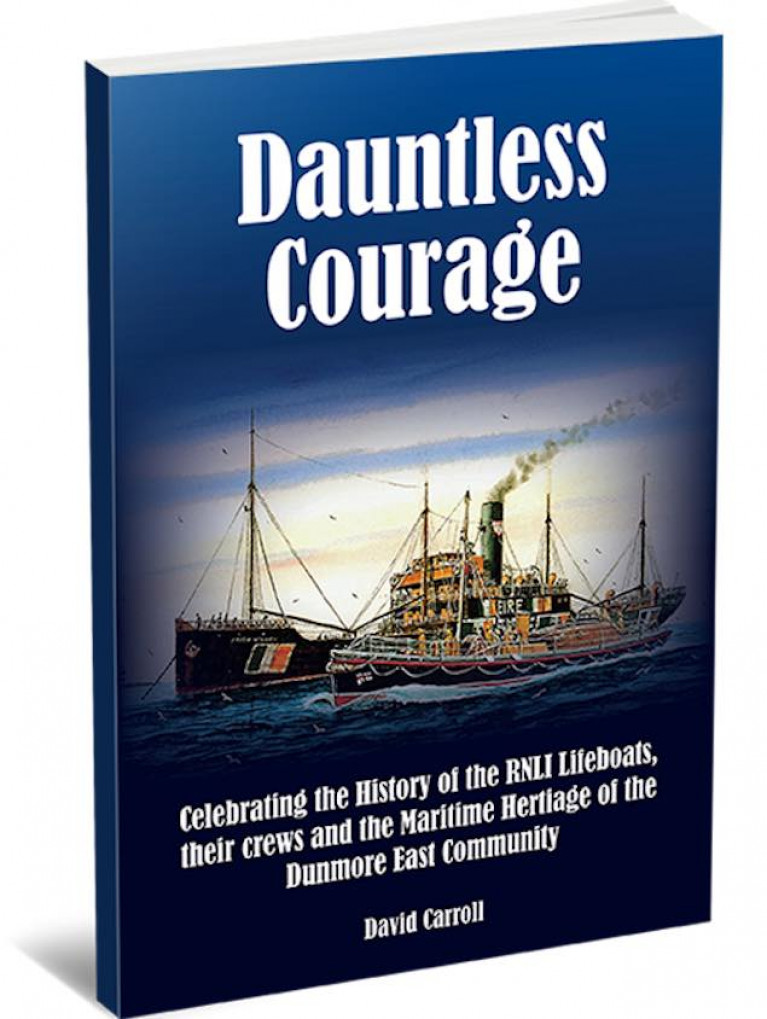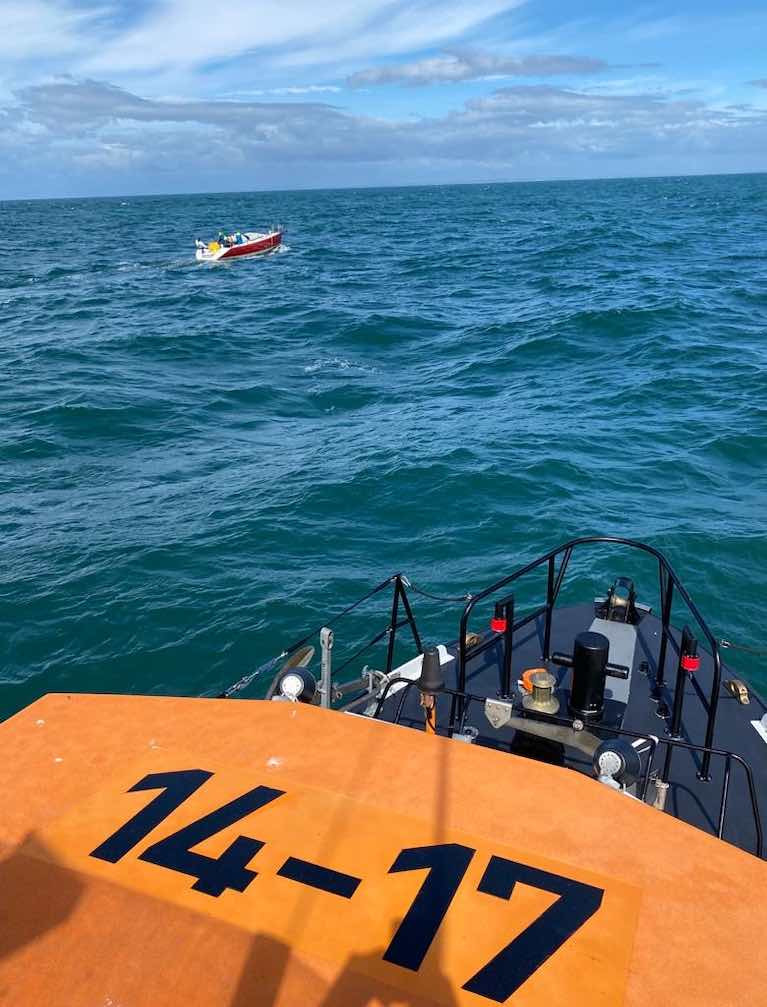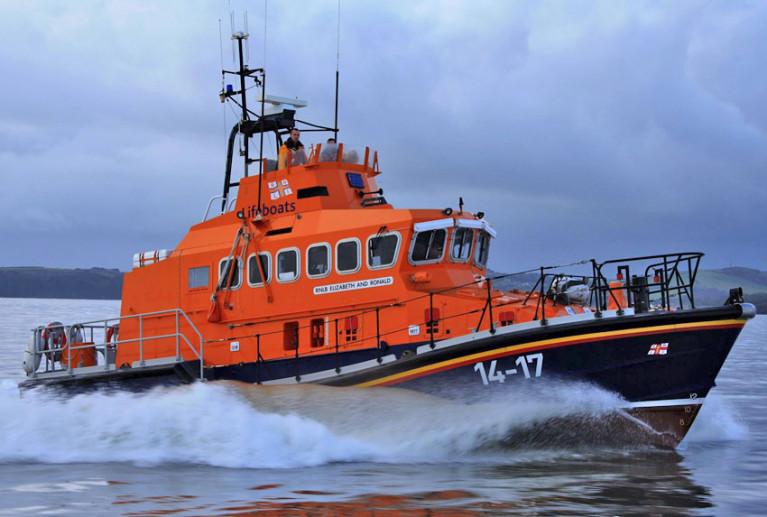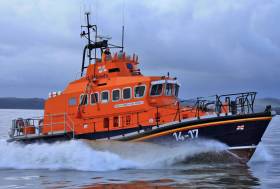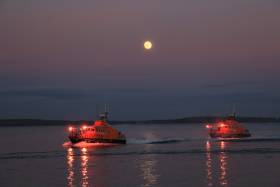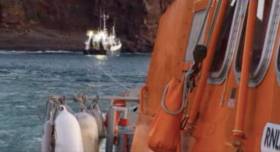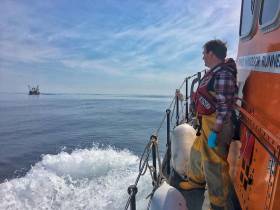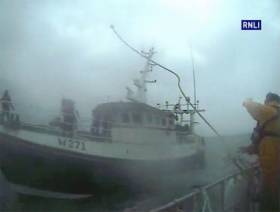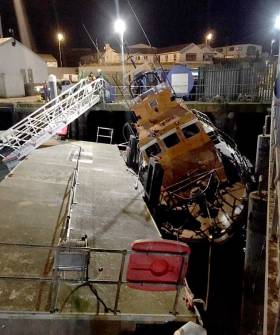Displaying items by tag: Dunmore East
Radio presenter Damien Tiernan will lead an online panel discussion (Wednesday 25 November at 8 pm) with ‘Dauntless Courage’ author David Carroll and Dunmore East RNLI volunteer crew members.
WLR FM radio presenter, former South East correspondent for RTE and author of ‘Souls of the Sea’ Damien Tiernan will lead the panel discussion with the author of ‘Dauntless Courage’ David Carroll who will also be joined by Dunmore East RNLI volunteer crew members Brendan Dunne and Neville Murphy. The launch is coinciding with the 50th anniversary of the Glenmalure Tragedy which is featured in the book.
‘Dauntless Courage’: Celebrating the History of the Dunmore East RNLI, their crews and the Maritime Heritage of the Local Community. All proceeds from the book will be going to the local Dunmore East Lifeboat Fundraising Branch to support the saving of lives on our seas.
After several years researching and writing of the book, the public unveiling will take place online with an in-depth panel discussion of the research involved in writing the book, the characters behind the lifejackets, the many acts of courage that took place far from shore, and a look at the local community that was so often the backbone of every crew that took to sea to save those whose lives were in peril.
The online event will take place on Wednesday 25 November at 8 pm for approximately forty minutes, with a live Q&A session for attendees afterwards. Registration for the event can be made here
David Carroll, author of Dauntless Courage said: ‘What has really struck me about writing this book has been the amazing goodwill and generosity of so many people who have helped to make this book possible, especially all the interesting and historic photographs and paintings that we have been given access to for inclusion in the book’.
 The book ‘Dauntless Courage’ celebrates the history of Dunmore East RNLI
The book ‘Dauntless Courage’ celebrates the history of Dunmore East RNLI
Damian Tiernan, WLR FM radio presenter said: ‘I am honoured and delighted to be hosting this discussion, I have a long association with members of the RNLI in Dunmore and I worked closely with them over the years. The publication is a wonderful record of all that has happened complete with superb pen portraits and descriptions of events and superbly written and produced’.
Purchase of the book can also be made here with all proceeds from the book going to the local Dunmore East Lifeboat Fundraising Branch to support the saving of lives on our seas.
Orders and further information on the book can also be made by contacting [email protected]
Dunmore East RNLI History 'Dauntless Courage' is Launched
Dunmore East RNLI has been saving lives off the South East coast since 1884. Since then Lifeboats based in the village have launched nearly 1000 times and saved over 305 lives and aided 1315 people in distress on the seas along the Waterford and Wexford coast.
David Carroll the son of Captain Desmond Carroll, a former Harbour Master in Dunmore is currently completing a book on the history of the Dunmore East RNLI Lifeboats and the community from which the crews are drawn. David grew up in Dunmore East and whilst moving from the village in his 20s to pursue a career he has always retained a great love for the maritime heritage he inherited growing up in the village. David has spent nearly two years researching this book which is now near completion. The book, which is based on archives both here in Ireland and the RNLI archives in Poole, England, will detail the boats that were stationed in Dunmore and the stories of the rescues they carried out. Also included in the book will be many interesting and unique photographs that have not appeared in public before. The story of the village itself, and its link as a fishing community with the Lifeboats and crews, brings the reader from the earliest times of saving lives at sea in the area up to the present.
 Author David Carroll is the son of Captain Desmond Carroll, a former Harbour Master in Dunmore
Author David Carroll is the son of Captain Desmond Carroll, a former Harbour Master in Dunmore
David Carroll, author of Dauntless Courage said: ‘“I feel that I have been extremely fortunate to have been given this wonderful opportunity of writing a history of the Dunmore East RNLI Lifeboats and their volunteer crews. As a small boy, I used to see the names of the Henry Dodd and Fanny Harriet on the records boards that were in a small fuel store on the pier. I never could have imagined that one day, I would be researching and writing about these famous lifeboats”.
Brendan Dunne, RNLI volunteer crew with Dunmore East RNLI said: ‘As crew we are delighted to see a book of this calibre been written. It is a testimony to the maritime history of the village and the volunteers who go to sea to rescue people in distress. David has ensured that the legacy of RNLI volunteers and supporters past and present will always be remembered in times eye and that the Lifeboat is an integral part of the community in Dunmore and surrounding areas’
Dauntless Courage: Celebrating the History of the Dunmore East RNLI, their crews and the Maritime Heritage of the Local Community. All proceeds from the book will be going to the local Dunmore East Lifeboat Fundraising Branch to support the saving of lives on our seas.
For pre-orders and further information on the book please see here
Red Alert - Dunmore East RNLI Assist Dismasted Fastnet 450 Race Yacht 36 Miles Offshore
At 7.26 am Dunmore East RNLI Lifeboat launched on service to assist a stricken yacht in the Fastnet 450 Race which had suffered a dismasting 36 miles South of Dunmore East on the County Waterford coast.
On reaching the Greystones-based yacht, Red Alert, the lifeboat crew conducted a quick assessment of the six yacht crewmembers who were in good spirits and thankfully did not need any medical assistance.
The JOD 35 type yacht which was taking part in the race that started yesterday from Dublin and was heading for the Fastnet lighthouse was still able to make its own way slowly under power and was escorted by Dunmore East lifeboat crew to the safety of Dunmore East harbour at 2.15 pm.
 The yacht Red Alert at the start of the Fastnet 450 Race from Dun Laoghaire Harbour on Dublin Bay yesterday Photo: Afloat
The yacht Red Alert at the start of the Fastnet 450 Race from Dun Laoghaire Harbour on Dublin Bay yesterday Photo: Afloat
Tony Kelly, Dunmore East RNLI Lifeboat Operations Manager said: ‘A shout like this really highlights how dedicated our volunteers are. They gave up their Sunday morning without hesitation to spend nearly 7 hours at sea, away from their families to selflessly help others. Thankfully, sea conditions were good at the time and all are now safely back onshore.’
The Fastnet 450 race continues with leaders expected to finish in Cork Harbour on Monday morning, race tracker here
Search For Missing Man Off Hook Head After Fisherman Dies Following Trawler Incident
RTÉ News reports that one man has died as the search continues for a second man after a fishing vessel is understood to have sunk off Hook Head last night (Saturday 4 January).
A man in his 60s was recovered in the early hours of this morning (Sunday 5 January) but died at University Hospital Waterford.
The Irish Coast Guard and RNLI lifeboat crews are involved in the search for a second individual believed to have been on the trawler south of Dunmore East.
Dunmore East RNLI launched yesterday (Tuesday June 11) in what turned out to be a nine-hour mission to assist a 24m fishing trawler with six crew on board.
The vessel had suffered a fouled propeller 40 miles south of the Co Waterford village — meaning a lengthy round-trip for the volunteer crew of the Trent class lifeboat Elizabeth and Ronald that began at 8.40am.
Yet despite the time — and some difficult weather at sea — there were few complications in the long tow with the strict vessel back to the safety of Dunmore East harbour, where they arrived just before 6pm.
“It was a long day for our volunteer crew and the conditions offshore today were challenging, which highlights the value of the training our crews conduct on a regular basis,” said lifeboat coxswain Roy Abrahamsson.
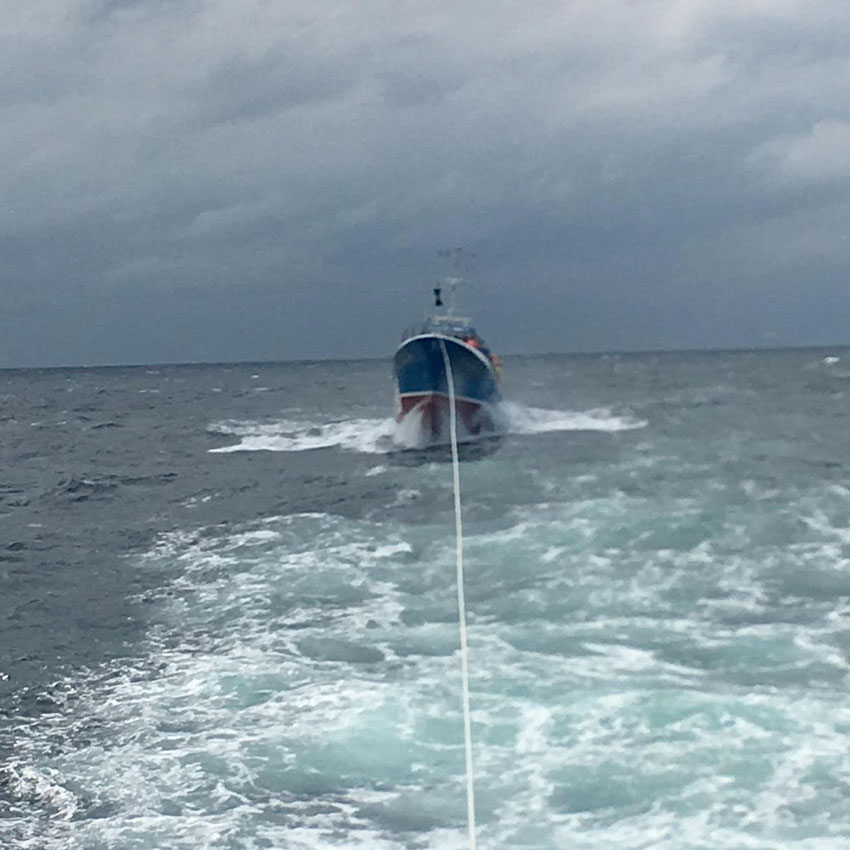 Dunmore East RNLI taking the stricken trawler under tow | Photo: RNLI/Roy Abrahamsson
Dunmore East RNLI taking the stricken trawler under tow | Photo: RNLI/Roy Abrahamsson
Dunmore East RNLI Lifeboat ‘Elizabeth And Ronald’ Returns To Service
#Lifeboats - Hundreds gathered on the high wall in Dunmore East on Sunday evening (20 January) to welcome the town’s all-weather lifeboat Elizabeth and Ronald back home after more than a year out of service.
On 1 December 2017, Dunmore East RNLI’s all-weather Trent class lifeboat sustained damage overnight while moored alongside its pontoon. Afterwards, the lifeboat was moved to Falmouth Boat Yard in the UK for repair.
Last week the lifeboat went through extensive sea trials before it was allowed to return on service in Dunmore East.
At 5pm on Sunday evening, people gathered on the high wall in Dunmore East to catch the first glimpse of the lifeboat as it returned home. Refreshments were served to all at the station house after in celebration of the lifeboat’s return.
The service has been maintained in Dunmore East with relief lifeboat 14-06 Windsor Runner on station.
The volunteer crews are having a busy period responding to three separate incidents this week alone. On Wednesday 16 January, the lifeboat crew assisted a 26m fishing vessel with engine trouble 10 miles South of Dunmore East.
And on Sunday afternoon, the crew assisted a 26m fishing vessel with engine trouble six miles South East of Dunmore East, as well as a 15m fishing vessel on rocks a mile north of Hook Head.
Ciaran O’Muaillain, RNLI lifeboat operations manager for Dunmore East RNLI, said: “It is fantastic to have our own lifeboat back again, our volunteer crew are very attached to Elizabeth and Ronald.
“It was a very emotional evening and I would like to thank everyone for coming out to support our lifeboat crew on this special evening.”
Dunmore East Lifeboat In Early-Hours Rescue Of Five Fishermen After Trawler Runs Aground
#Lifeboats - Dunmore East RNLI’s all-weather lifeboat launched in the early hours of yesterday morning (Thursday 1 November) to a 23m fishing trawler that had run aground with five people onboard half a mile south-west of Dunmore East Harbour.
At 2.06am, the Dunmore East RNLI all-weather lifeboat launched on service to assist the fishermen.
Minutes after the launch, the Trent class lifeboat Windsor Runner arrived on scene to find the trawler high and dry on the rocky shoreline with an ebbing tide.
The five crew onboard the trawler were in no immediate danger, so it was decided to wait for the tide to rise again and then tow the vessel off the rocks.
Dunmore East’s lifeboat crew remained on scene and at 7am the trawler with five crew onboard was successfully towed away the rocks undamaged and was able to make its way under power to Dunmore East Harbour.
Escorted by Dunmore East RNLI’s lifeboat, they made the safety of the harbour at 7.20am.
Dunmore East RNLI coxswain Michael Griffin said: “The conditions on scene were good at the time and thankfully the trawler didn’t sustain any major damage.
“Credit to our volunteer crew who worked tirelessly during the early hours of this morning to ensure the success of the mission.”
Dunmore East Lifeboat In Medevac 50 Miles Offshore
#RNLI - Dunmore East RNLI’s all-weather lifeboat launched on Saturday (21 April) to assist an injured crewman onboard a fishing trawler.
The crewman sustained an injury while fishing 70 miles offshore, and the trawler was intercepted by Dunmore East lifeboat 50 miles south of Dunmore East to conduct the medevac.
At 11:50am, the Trent Class lifeboat Windsor Runner launched with a transit time of two hours and 35 minutes to the scene, where it came alongside the trawler to transfer the casualty.
The injured crewman was administered first aid treatment and monitored by the lifeboat crew while routing back to Dunmore East Harbour, where he was handed over to the Ambulance Service at 4.45pm.
Dunmore East RNLI coxswain Michael Griffin said: “The sea conditions [on Saturday] were very good which helped in the transfer of the casualty to our lifeboat, our crew are highly trained in casualty care, and the injured man was very well looked after until he was handed over to the ambulance crew.”
Dunmore East Lifeboat Rescues Trawler Drifting Onto Rocks
#RNLI - Dunmore East RNLI’s all-weather lifeboat launched yesterday afternoon (Tuesday January 9) to assist a 23m trawler with four crew on board.
The fishing vessel had suffered engine trouble and was drifting onto rocks one mile northeast of Dunmore East Harbour, close to the shoreline.
Minutes after launch at 1.58pm, the all-weather Trent Class Dunmore East lifeboat Windsor Runner arrived on scene to find the trawler drifting close to the rocks.
In difficult sea conditions and high winds, the Dunmore East RNLI crew managed to get a line to the stricken vessel and established a tow.
The vessel was then towed to the safety of Dunmore East Harbour at 2.40pm. The Irish Coast Guard helicopter Rescue 117 and Dunmore East Coast Guard were also launched.
Dunmore East RNLI operations manager Ciaran O’Mullain said after the callout: “A quick response from our volunteer crew today ensured we got to the vessel before it drifted onto the rocks.
“Sea conditions made the rescue difficult today but thankfully our highly trained crew were able to bring the trawler and its crew to the safety of Dunmore East Harbour.”
Dunmore East Lifeboat Out Of Action After Harbour Incident
#RNLI - Dunmore East RNLI’s all-weather lifeboat sustained damage overnight while moored alongside its pontoon in the Co Waterford harbour.
Impact by another vessel in the early hours of this morning (Friday 1 December) resulted in damage to both the pontoon and the Trent class lifeboat.
Details are unclear but a report on RTÉ News suggests that the lifeboat was damaged after a fishing boat manoeuvring in the harbour collided with the pontoon.
No lifeboat personnel were involved by the incident, which was not related to any RNLI activity and has been reported as a matter of course to the Marine Casualty Investigation Board.
While the lifeboat is off service for repairs, search and rescue cover will be provided by the closest RNLI stations, as well as the Irish Coast Guard crews based in Waterford. A relief lifeboat was scheduled to arrive this evening.
WLR FM's Twitter account has a short video clip of the damage sustained to the lifeboat in the harbour this morning:
WATCH: Dunmore East RNLI lifeboat damaged in harbour crash. #DunmoreEast #RNLI Read the full story here https://t.co/YbVY3sVZsv and listen to #WLRnews for more. pic.twitter.com/lKTMjrDxDo
— WLR (@wlrfm) December 1, 2017


























